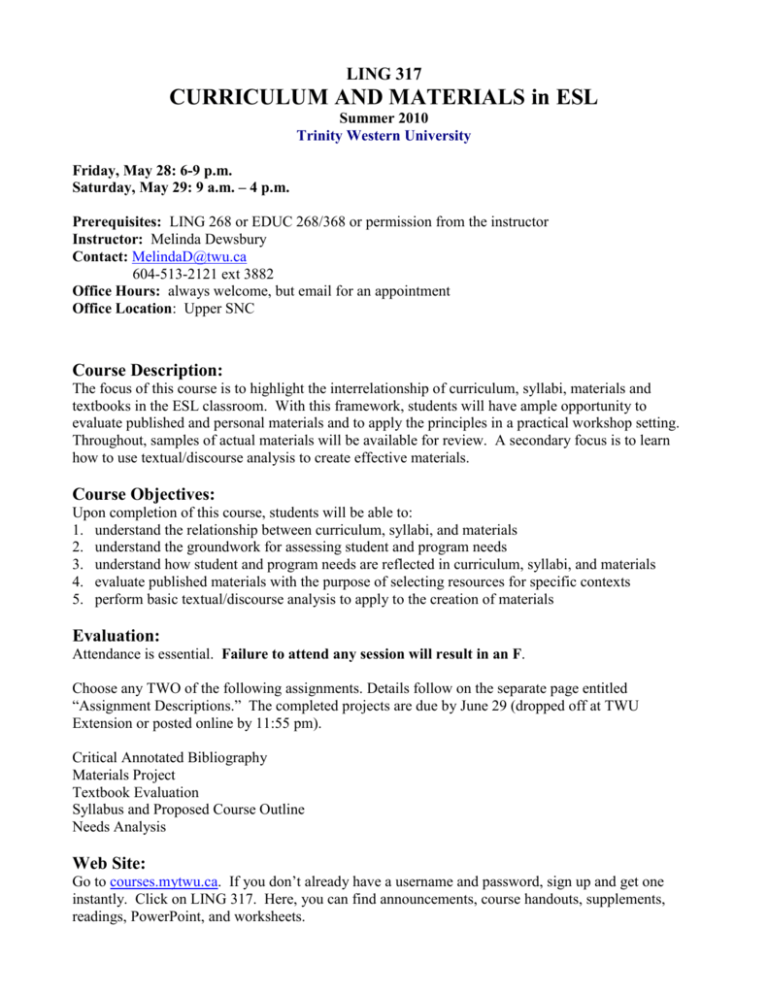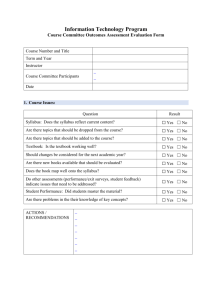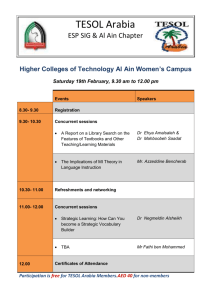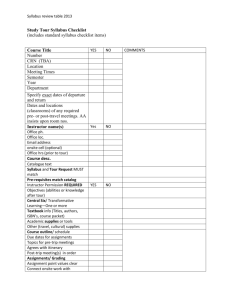assignment descriptions - Trinity Western University
advertisement

LING 317 CURRICULUM AND MATERIALS in ESL Summer 2010 Trinity Western University Friday, May 28: 6-9 p.m. Saturday, May 29: 9 a.m. – 4 p.m. Prerequisites: LING 268 or EDUC 268/368 or permission from the instructor Instructor: Melinda Dewsbury Contact: MelindaD@twu.ca 604-513-2121 ext 3882 Office Hours: always welcome, but email for an appointment Office Location: Upper SNC Course Description: The focus of this course is to highlight the interrelationship of curriculum, syllabi, materials and textbooks in the ESL classroom. With this framework, students will have ample opportunity to evaluate published and personal materials and to apply the principles in a practical workshop setting. Throughout, samples of actual materials will be available for review. A secondary focus is to learn how to use textual/discourse analysis to create effective materials. Course Objectives: Upon completion of this course, students will be able to: 1. understand the relationship between curriculum, syllabi, and materials 2. understand the groundwork for assessing student and program needs 3. understand how student and program needs are reflected in curriculum, syllabi, and materials 4. evaluate published materials with the purpose of selecting resources for specific contexts 5. perform basic textual/discourse analysis to apply to the creation of materials Evaluation: Attendance is essential. Failure to attend any session will result in an F. Choose any TWO of the following assignments. Details follow on the separate page entitled “Assignment Descriptions.” The completed projects are due by June 29 (dropped off at TWU Extension or posted online by 11:55 pm). Critical Annotated Bibliography Materials Project Textbook Evaluation Syllabus and Proposed Course Outline Needs Analysis Web Site: Go to courses.mytwu.ca. If you don’t already have a username and password, sign up and get one instantly. Click on LING 317. Here, you can find announcements, course handouts, supplements, readings, PowerPoint, and worksheets. Textbooks and Materials: No purchased textbooks are required. Students must download and/or print two packages prior to the weekend seminar: LING 317 Course pack Collection of Self-Made Materials Following the seminar, students are expected to use the additional readings and resources posted on mycourses. Proposed Course Outline: Friday 6:00-6:30 6:30-7:15 7:30-9:00 Sat 9:00-9:45 9:45-10:15 10:30-noon 1:00-2:15 2:30-4:00 Understanding the concepts and relationships of curriculum, syllabus, and materials Needs assessment basics Understanding and evaluating curriculum Syllabus design: considerations and principles Considerations in choosing and using textbooks Textbook Evaluation Considerations in teacher-made materials; introduction to textual analysis Workshop Class Format: The seminar will combine lecture, class discussion, group work, pair work, and hands-on analysis and creativity. Students are expected to be active participants. ASSIGNMENT DESCRIPTIONS Choose TWO of the assignments listed below. It would be best if the two were (for example, focusing on the same setting). connected Option 1. Annotated Bibliography Read FIVE academic articles or chapters (approximately 5-8 pages each) on curriculum, syllabus, and/or materials development. Note that these should NOT be chapters from ESL textbooks but rather theory, studies, reports, critical essays, etc. I have posted a number of books and articles online. You may also consult other sources, such as the Internet TESL Journal or TESOL Quarterly. The articles you choose should examine curriculum design, syllabus design, materials or textbooks. Please do not include articles on teaching methodology, classroom management, or other topics in the field. Each annotation should be two paragraphs in length. Be sure to include the full bibliographic information for the reading, in APA format (ordered alphabetically). Write in a formal tone, but feel free to use a personal voice. Use the following guidelines to create each annotated bibliography entry: 1. Summarize the source, including the following information (approx 100 words) -the author’s background (general) and credibility in the field -a comment on the significance of the article, if applicable (for example, if it is very well-known or if it is a small how-to article) -a summary of the article’s thesis or primary arguments -how this article contributes to your understanding of LING 317’s topics and discussions (For example, does it reinforce something you learned? Does it challenge or contradict something we discussed? Does it expand your knowledge?) ** Avoid simply copying the table of contents or listing a series of quotes. 2. Respond to and critique the article’s content (approx 100 words). Do not just repeat what you read. Here are some questions to get you thinking: -Does this reading give you a new perspective or insight? How? -Do any points stand out to you? Why? What is significant? -Do you disagree with any of the article’s points or applications? Explain. -Does the article match with your own experience or expectations? -Does the author’s logic make sense? -How can you apply this article to your current/future teaching? Option 2. Materials Project: Analyze an authentic item and use it to create your own materials. Choose ONE authentic item (a newspaper article, the classifieds, the telephone book, a pamphlet, a book, a magazine, an advertisement (or pages of ads), a receipt, an application, a song, a movie or TV program, a website…). Do not discuss this generically (“a song”) but specifically (“Jesus loves me.”) Submit a copy of the item, either the original or scanned/copied (not necessary for a movie or TV show). This assignment includes three parts, described below. Textual Analysis 1) Fill in the textual analysis worksheet (posted online). Do this thoroughly. 2) Based on your analysis, summarize ALL of the features you consider to be the most dominant (max 100 words). Be specific here. Do not just say “vocabulary” but rather “descriptive adjectives.” Do not just say “grammar” but rather “passive and active voice.” 3) Narrow down to a specific feature that you will now develop into materials. For example, you may decide to develop worksheets to focus on non-count nouns. State the following: The feature you have chosen (based on your analysis) The language level you are targeting The situation/context you are targeting (community-based class, EAP, EFL, after-school program, workplace program, etc.) Why you think this reading and this focus are appropriate. Materials Using the same item, and your conclusion from your textual analysis, develop TWO complete materials to be used in the classroom. NOTE: These materials must use the authentic item directly. Do not just use the same topic (i.e. food) but rather, use the sentences, structures, vocabulary, layout, etc. from the item (i.e. grocery flyer). You may even want to scan or photocopy sections of the original item so that it appears on the materials (i.e. a worksheet that includes cut-outs of the ads). These should be your own self-created materials. They should be professionally made – no pen and ink, no hand-drawn pictures (unless you are an artist/illustrator). These items should be EXACTLY what you want your students to see. Examples of materials: a worksheet, an exercise, an instructional handout, a quiz, a game, a grammar handout, flashcards, overhead transparencies, PowerPoint, etc. Teacher Notes Offer any instructions needed to understand the use of your materials. If you develop a game or other kind of interactive activity, write your instructions professionally, as would appear in an “Instructor’s Guide.” Suggest any possible problems that may occur in the use of the materials and how the teacher could respond to these problems. Suggest alternatives and modifications (for example, shorter versions of a game or how to adapt for a multi-level classroom). Option 3: Textbook Evaluation Choose a textbook that you are interested in for current or future teaching. This should be a relatively recent book (not outdated). Using the issues discussed in LING 317, design your own checklist that reflects what you consider to be important in textbook evaluation. This checklist should be detailed and should present the weighting of your criteria (which criteria are most important). Apply your checklist to the textbook. Write a 3-4 page (double-spaced) review in which you: 1. State the bibliographic information of the book. 2. Introduce the book – its topic and purpose, the perspective or ideology it is based on. Also include your thesis statement that states your overall evaluation of this text (strengths and weaknesses). What rating do you give it? 3. Summarize the contents, types of materials, etc. (one page or less) 4. Explain your evaluation. Give clear examples from the textbook by referring to specific pages and by quoting specific sentences or sections. Include comments based on what we discussed in 317. 5. Write a response to your checklist. Did this checklist work for you? Is there anything you would add or change? Was this a useful exercise? (one page or less) 6. Conclude by giving your overall recommendation of this textbook. 7. Include your checklist in the appendix. Option 4: Syllabus and Proposed Course Outline If you are already teaching or if you have taught a class in the recent past, you may choose to design a syllabus and unit plan for your class. 1. Write a setting description to introduce the students, the school, and the course. (1/2 page) 2. Decide on an appropriate syllabus design. Describe and justify your choice. (1/2 page) 3. Develop the syllabus itself, including: Course description Goals and/or objectives (minimum of 6) Course Expectations Course materials (optional – if you already use a text or if you’d like to incorporate a text or other materials, you may list those resources) Assessment/breakdown of grades (if students are not formally assessed, include a statement about how you would give students feedback) 4. Develop a Proposed Course Outline, in which you reflect the syllabus organizational design, the balance of time allotted to each topic, the kinds of lessons you will focus on. 5. Write a rationale to explain your choices throughout the syllabus. Explain how your choices match the setting and the student and program needs (2-3 pages). Refer to principles we discussed in LING 317. Option 5: Needs Analysis 1. Choose a setting. This may be an actual setting (a real class) or a hypothetical setting (see the list of settings posted online). Describe this setting very briefly (maximum ½ page). 2. Use the Who, What, When, Where, Why Needs Analysis Template to examine the needs of this setting (students and program). This is based on a thoughtful estimation of the group’s needs, but a real analysis would develop based on data collection from a focus group. Submit your completed template. 3. Imagine that you are responsible for creating a curriculum for this setting. Using your completed analysis AND the “curriculum ladder,” create a list of at least ten recommendations for curriculum. This could include the content to be covered but it may also include recommendations for scope and sequence, timing, focus, etc. Note that you do not have to design the actual curriculum document. Rather, this is a preliminary step. This set of recommendations should be approximately 3 pages (each recommendation explained in a brief paragraph). Refer directly to concepts and terms from LING 317.







